By design, Julian Glander’s BOYS GO TO JUPITER feels unassuming. If you’ve been on the Internet at all in the last decade-and-a-half, you’ve likely come across the 3D animator, designer, and illustrator, and now with his turn as a screenwriter and director for his debut feature, he’s crafted a thoughtful film that is anxious and calming in equal measure.
With a who’s who voice cast of alt comedy stars including Cole Escola, Julio Torres, Demi Adejuyigbe, Joe Pera, Sarah Sherman, Elsie Fisher, Chris Flemming, Janeane Garaflo, and many more, plus lead performances from Jack Corbett, the host of NPR’s Planet Money, and musician Miya Folick, BOYS GO TO JUPITER threads a careful needle, offering voices, sounds, and textures that are deliberately fascinating to see and hear play out on screen. The unique technicolor fusion of malaise and ennui results in something so cute it’s almost comforting. The script, performances, and visuals hone in on the gig economy, tech, capitalism, and youth culture in a way no other animated film has—plenty of films released in 2025 feel timely, but few feel like they could be timeless the way BOYS GO TO JUPITER does. To quote Glander: “We (thought we) had a future—that has been disproven.” This is a movie for those times.
Below is my conversation with Glander, where we discuss how that cast ended up influencing aspects of the script, how being a freelance illustrator and designer for 20 years molded his work ethic for this film, grind culture, and more!
You’ve worked on so much interesting stuff—video games, web comics, even down to, like, promotional .gifs with companies like Nike or Disney or Adult Swim or whatever. What was the mental process like as a freelance employee for some fairly, fairly heavy hitters to work on something indie like this? Those are all massive corporations and institutions. Were there things that you learned from the process of working on those projects that differed from what you learned making your own independent film?
Julian Glander: I actually think one of the challenges was getting the imaginary producer, or the imaginary development person, out of my head. Just from working for art directors for so long, you know what people are going to say no to. And as I was writing it, it was sort of like, well, no studio exec would want me to end the movie this way, or no one would want these characters to say these things to each other. And it sort of became a little bit of a fun, rebellious exercise—what’s the musical number here that no art director or no producer would let me do. But beyond that, working for all those clients, I learned a lot of philosophical things. I think the biggest thing of working in illustration is you have to learn how to work fast and you have to learn how to create clarity and communicate things basically instantly.
And I think a lot of the way the movie is visually set up is so informed specifically by editorial illustration that I’ve worked on. And I think the other great thing—the thing that I have dragged my feet through as an illustrator—is oftentimes an art director or producer will ask you to draw or model something that you really don’t want to, or that you really don’t know how to do. Like for me, it’s always been cars have been something that I really—I just can’t get it. I can’t make a good-looking car; I can never make a 3D car that I’m happy with.
While I was kind of developing the movie, I was working on a New York Times article about these moon rocks. The story was, basically astronauts were bringing rocks back from the moon and they were concerned that they would have bacteria on them that we didn’t know how to deal with. So I created all these kinds of scientific, sci-fi, spaceship-y chambers that ended up informing the sci-fi-like orange juice lab in the movie, like, pretty heavily. So I think being pushed by an art director to draw the stuff that’s outside of your beloved subject matter was a big place of growth for me as an illustrator.
Now that you have had the full creative independence to be able to just do the thing you want, do you look back at other projects that you’ve worked on where you were getting noted up, where you were like, “I was obviously correct”?
JG: No, I’m always correct, but I’m also a brat. *laughs* Certainly at the beginning of my career I had a very intense idea about how an artist was supposed to be. And I thought I was supposed to fight for everything and push back on everything. And I definitely think about times when it’s, like, I’m fighting with a client for some tech company that I don’t care about at all, and just think, why? It must be because I love fighting. There’s no other explanation for it.
But also your visual style is so distinct. To even push back on it a little bit feels like, well—why did you hire me in the first place, right?
JG: You’re validating a lot of my worst impulses here, which I love. *laughs*
I was going to ask, how old are you?
JG: I’m 35. So, I’ve been doing this for a long time. I started doing graphics when I was probably 15 for threadless.com. So it’s been 20 years of basically making stuff for the internet.
So I’m 33. And I figured reading interviews and doing research that we were similar ages. But I ask that question not to be annoying and publish your age online but to ask what led you to a story specifically about teenagers and the gig economy? Because this examination of tech and capitalism and the feeling of detachment and dehumanization that we’ve kind of gone down is oftentimes explored in, like, this kind of post-grad world, or, like, or even, like, further down the line people our age—not necessarily this wunderkind 17-year-old kid like Billy 5000. Where do those two things collide for you and how did you kind of arrive at that?
JG: I see the pressures of the gig economy trickling down. And when I talk to really young people that I know, they are thinking about this stuff at age 14 in a way that I think our generation wasn’t. We’re millennials, so I think we kind of grew up in the self-esteem movement with this idea that we had a future—that has been disproven, fine. In the pandemic I felt like I was going through adolescence again. Like, I felt very confused by the world, I felt like just when I had learned all the rules they had been sort of scrambled. And I really felt like I was outgrowing a lot of my peers—or not even outgrowing, but just growing apart from a lot of the people around me. And I also think in some ways, a teenager’s life is easier to write because you don’t quite have as many of the complications you or I have; there’s this sort of, like, built-in world that a teenager lives in with their family and their school and their community that makes it an easier basis to tell a story that I think we can all kind of find some access point to.

Hearing you say that you went through adolescence again during the pandemic is so interesting. I thought the choice to examine those young people was brilliant, and I think that this whimsical idea that his whole life is ahead of him while also living in the kind of quiet devastation that this grindset is possibly going to derail all of that—even though it’s presented in a way that maybe isn’t that forwardly direct—was really powerful.
JG: It’s funny, this seems to be where all the interviews go—to, like, the darkness of the world, which is in the movie. But I also—I mean, all the characters are hopeful. They all do have this kind of classic American thing, in which basically every character in the movie believes that they’re going to be rich someday, which if I’m being honest, I also kind of believe that even though there’s, like, no evidence pointing to it. That sort of uneasy feeling I think comes from the way the movie presents the characters—we have this sort of, like, top-down distance and we almost know just from the way they’re talking about being rich, or having stability, that it’s not going to happen for them. And so there’s a creeping sense of dread in there.
I don’t even view any of the darkness or evilness within the characters directly, really, other than the Demi Adejuyigbe character, Mr. Moolah—I would push back and say, like, I don’t know what that guy is necessarily providing other than a kind of manipulation of the teen spirit.
JG: He’s so toxic. But also, if you freeze-frame and look at it, he’s a YouTube money guru who talks about, like, five-dimensional money strategy, but his videos are getting, like, 100 views and three comments.
Oh, that’s funny. That’s a detail I didn’t pick up on.
JG: He’s also, like, kind of a huge loser. *laughs*
What he’s presenting in those videos is not that far away from what an economics professor might tell you or something in a far more academic-y kind of way, but also yeah, huge loser.
JG: I watch a lot, and get fed a lot of hustle culture stuff. I was really, really obsessed with this guy Gary V for a long time. But now I feel like it’s evolved. We’ve gone past this sort of idea of work and grind and you’ll get rich, it’s now almost like a mystical view of money—like it’s something to be manifested. It’s something to be gained using numerology and astrology. And that’s what happens, I think, when all systems kind of stop making sense. But I think Mr. Moolah also presents this idea that there’s an amount of money that you are destined to have. And again, that is kind of true. Generally, as we see amidst the collapse of the meritocracy, there is sort of a range of money that I’m going to make in my life that was predetermined before I was born. But as with all kooky online theories, it’s not in a fun, mystical way. It’s in a very boring way.
I was curious about some of the references for characters—like the Sarah Sherman character, Miss Shannon, or also the Joe Pera character, Herschel Cretaceous. Both of those characters in particular kind of feel ripped out of those actors’ identities. Like, the way that you open on Herschel and introduce him is ostensibly a JOE PERA TALKS TO YOU bit; the way he’s framing everything, you’re kind of teeing up for, like, what would be the start of one of those episodes. Where did the recording and the animation and then the script itself all kind of collide for those types of bits, or am I wrong in that read?
JG: No, you’re not wrong at all, I mean certainly it’s an ensemble cast and there are a number of characters who have isolated scenes where they just kind of philosophize, and those are two of them. The Miss Shannon character that Sarah Sherman plays was originally written as kind of more of a crazy cat lady, or like somebody who’s pushing around a shopping cart full of cans. But I really thought as I was getting ready to email the script to Sarah that it should be like a John Waters character, that the character should use her bigness and the way she just, like, really opens up her whole body every time she speaks.
And the Joe one I honestly think it’s just because his voice is so strong that it’s, like, he could read anything and it would become a Joe Pera thing. This is true for a lot of what’s in the movie, but I think what’s on the page is not as gentle and thoughtful and personal as it is when these people bring it to life. I also didn’t realize how much people love Joe Pera. I knew he was a fan, and I knew his show was great. But I didn’t realize the sort of cult and the intensity around him—like on the Joe Pera subreddit, somebody went and saw the movie and, like, timed it out with how much he’s in the movie, and they made a post like, “Heyy, Joe Peraheads, he was only in this for a minute-and-a-half, so in terms of Joe for your buck, it’s not that much.” *laughs*
Wow, what was the rest of the response on the subreddit—were people like, I saw it and it’s still great, or like, not for me, not enough Joe?
JG: You know, it’s Reddit. So it’s very much like, oh, well, “Thank you for the information, my good sir. I’ll check it out on an airplane.”
There’s such a cult to Joe, for sure. I mean, I don’t know whether or not I consider myself fully a part of that, but I definitely love him. And obviously, he’s a massive sell-point if you’re a fan and you see him on the poster—I feel like the average JOE PERA TALKS TO YOU fan should go see the movie.
JG: Maybe it’ll turn around. I think certainly something that resonates with me about Joe’s work is the gentleness, and I think people want more of that. I think one of the big bets we made making this movie was this idea that there’s an audience that’s underserved that wants things that are thoughtful and careful and patient and not so in-your-face. And it’s so rare to get an animated movie that does that. And it’s great to have a cast that sort of is on the same page with that stuff. The one kind of mandate we had recording was, like, no anime voices and obviously, like, Joe Pera doing anime, which would be like the silliest thing ever—actually though, I do wish we had done that as an exercise, just to see that one take. *laughs*

With regards to the casting and voices, I know that Miya Folick went to school for theater or acting of some kind. She obviously performs a song in the movie; how much was that role always going to be someone that was musical? I think I read somewhere that you just kind of reached out on Instagram, but, like, how did Miya even come out as an idea for someone that could be good for this role?
JG: That was, like, our big one that was really hard to fail, because the song was very important to me—like, as a textural piece, I think it’s the best thing in the movie. It’s a really beautiful song. And we were doing this big search… like, we would hear a singer and then we’d listen to them in a podcast or in an interview and the speaking voice wasn’t right. Or we’d find someone whose speaking voice was right, an actress who also wanted to be a singer and the singing was totally wrong. And Miya was like that magic person who, in interviews there’s this element of mystery, and she’s really carefully choosing her words—that’s really nice for the character. And then, yeah, we reached out on Instagram, and she called me on the phone and we had a very direct talk about the character, which I wasn’t really expecting to do.
Was she always going to sing?
JG: She was always going to sing a song in it, yeah. So we’re very lucky to have her in the movie. I mean, the song is, like—we have a demo of it that’s me singing, and it would make your ears bleed compared to what she brings in there. I mean, it’s so good that I use it twice in the movie.
The music is incredible. There’s a little bit of Yellow Magic Orchestra in there, a little bit of early M83. I feel like there’s a lot of, like, various ambient artists I can name-check. It’s just a beautiful hodgepodge that I think truly works. But the Mia track, especially, is clearly the one everyone’s, like, alright, we’ll playlist this one. Are you guys going to be putting the album out on vinyl or have you thought about doing that kind of thing?
JG: We are. We’re kicking it around. I’m so superstitious about this stuff. But yes, we are kicking it around and trying to figure it out. I would love to do it.
You can hear the aforementioned soundtrack for BOYS GO TO JUPITER over on Bandcamp, and you can still catch select screenings across the US here!


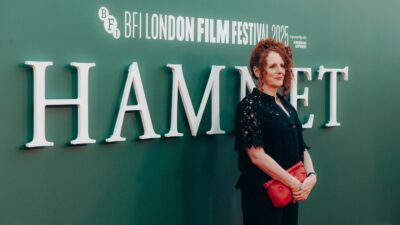

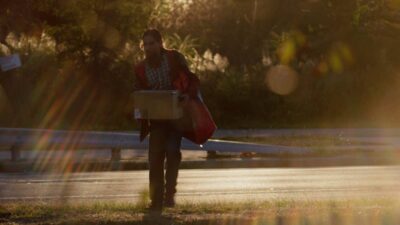



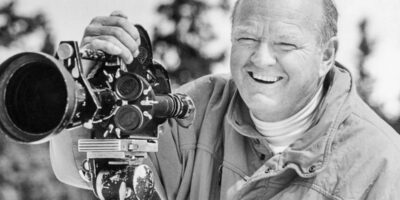



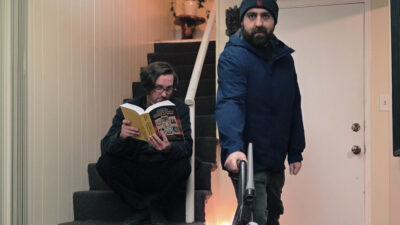
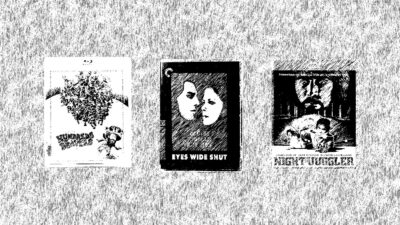
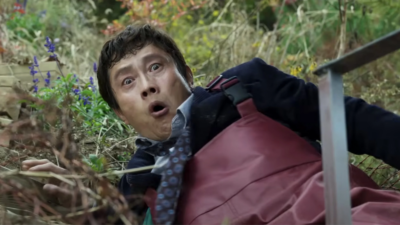
Comments